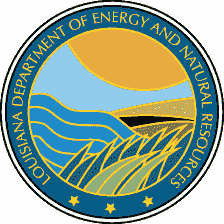Office of Mineral Resources
Pipeline Map and Database Produced for State

The U.S. Minerals Management Service (MMS) and theLouisiana Department of Natural Resources (DNR) signed a cooperative agreement two years ago, to produce a map and maintain a database of pipelines in the offshore waters of the state of Louisiana. MMS and DNR have now completed the project which involved many man-hours, research, and GIS (geographic information systems) expertise.
In Louisiana, several state agencies have varying regulatory authority over pipelines in marshlands and offshore waters that abut federal waters. Since the Coastal Management Division(CMD) of DNR has regulatory authority to permit pipelines in the Louisiana coastal zone, both agencies agreed that DNR would be the most appropriate entity to maintain the database of pipelines in the state offshore waters. MMS is also currently working with other states to incorporate into their databases, the location of pipelines, as mandated in the Oil Pollution Act of 1990.
From the onset, DNR Coastal Resources Scientist Manager Karl Morgan said this joint mapping agreement began with two goals; to map pipelines permitted by CMD in the entire coastal zone, and then to capture all of the pipelines installed in state offshore waters prior to the inception of the CMD permitting program in 1980.
Several government agencies and the U.S. Department of Interior were relied upon for specific data, records, and research as the DNR managers compiled and completed their work.
The mapping and database for the pipelines were developed by using a state of the art geographic information system. Considered a powerful technological tool, GIS allows any digital data to be overlaid upon other data sets with analysis performed through searching or querying any of the data fields or by location. The sources of data used to map the offshore pipelines include the CMD permit files, MMS files, the Louisiana State Land Office/Rights of Way, the Pipeline Safety Division at DNR, and theLouisiana Geological Survey.
Companies and contractors that work in the oil and gas field, government agencies, oil spill response teams, and industries such as shipping and fishing, that operate in state waters benefit from knowing where pipelines are situated so as to avoid damaging lines during their operations. Having and maintaining the database and pipeline map will provide a means of quick notification to all the necessary authorities that respond to leaks or spills.
As the project was being finalized, DNR worked with the Louisiana State Police to provide the data since they are the designated first contact for oil spill notification and response in Louisiana waters. Morgan said the data is not yet available to the public since homeland security issues are still being reviewed.
However, State Police and the U.S. Coast Guard will have the new pipeline map for use in responding to incidents. State Police should be contacted at 877-925-6595, if anyone sees or witnesses a spill or incident in Louisiana state waters.
Inquiries for the map should be made to Louisiana Homeland Security Office at 225-925-7500.
Editors: This news article is a reprint from the 2003 Fall issue of Coastlines newsletter ![]() produced by the Department of Natural Resources. For more information, contact the DNR Public information Office at225-342-8955.
produced by the Department of Natural Resources. For more information, contact the DNR Public information Office at225-342-8955.
News Archives »
